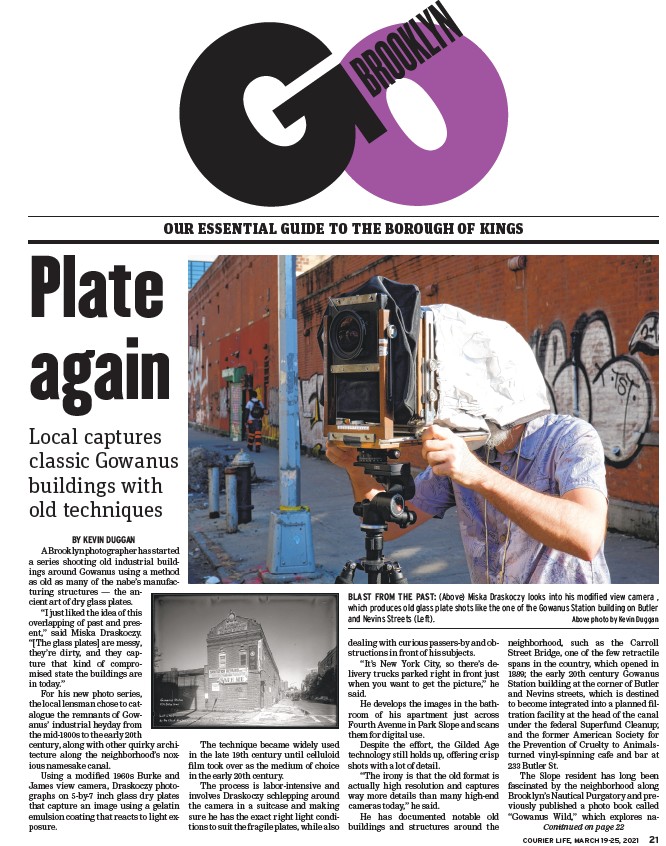
OUR ESSENTIAL GUIDE TO THE BOROUGH OF KINGS
COURIER LIFE, MARCH 19-25, 2021 21
BY KEVIN DUGGAN
A Brooklyn photographer has started
a series shooting old industrial buildings
around Gowanus using a method
as old as many of the nabe’s manufacturing
structures — the ancient
art of dry glass plates.
“I just liked the idea of this
overlapping of past and present,”
said Miska Draskoczy.
“The glass plates are messy,
they’re dirty, and they capture
that kind of compromised
state the buildings are
in today.”
For his new photo series,
the local lensman chose to catalogue
the remnants of Gowanus’
industrial heyday from
the mid-1800s to the early 20th
century, along with other quirky architecture
along the neighborhood’s noxious
namesake canal.
Using a modifi ed 1960s Burke and
James view camera, Draskoczy photographs
on 5-by-7 inch glass dry plates
that capture an image using a gelatin
emulsion coating that reacts to light exposure.
The technique became widely used
in the late 19th century until celluloid
fi lm took over as the medium of choice
in the early 20th century.
The process is labor-intensive and
involves Draskoczy schlepping around
the camera in a suitcase and making
sure he has the exact right light conditions
to suit the fragile plates, while also
dealing with curious passers-by and obstructions
in front of his subjects.
“It’s New York City, so there’s delivery
trucks parked right in front just
when you want to get the picture,” he
said.
He develops the images in the bathroom
of his apartment just across
Fourth Avenue in Park Slope and scans
them for digital use.
Despite the effort, the Gilded Age
technology still holds up, offering crisp
shots with a lot of detail.
“The irony is that the old format is
actually high resolution and captures
way more details than many high-end
cameras today,” he said.
He has documented notable old
buildings and structures around the
neighborhood, such as the Carroll
Street Bridge, one of the few retractile
spans in the country, which opened in
1889; the early 20th century Gowanus
Station building at the corner of Butler
and Nevins streets, which is destined
to become integrated into a planned fi ltration
facility at the head of the canal
under the federal Superfund Cleanup;
and the former American Society for
the Prevention of Cruelty to Animalsturned
vinyl-spinning cafe and bar at
233 Butler St.
The Slope resident has long been
fascinated by the neighborhood along
Brooklyn’s Nautical Purgatory and previously
published a photo book called
“Gowanus Wild,” which explores na-
Plate
again
Local captures
classic Gowanus
buildings with
old techniques
BLAST FROM THE PAST: (Above) Miska Draskoczy looks into his modifi ed view camera ,
which produces old glass plate shots like the one of the Gowanus Station building on Butler
and Nevins Streets (Left). Above photo by Kevin Duggan
Continued on page 22